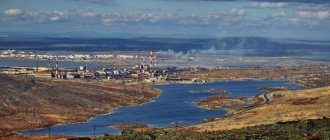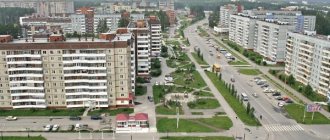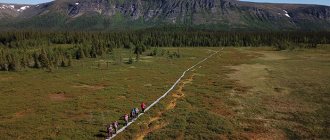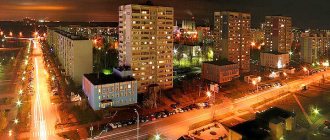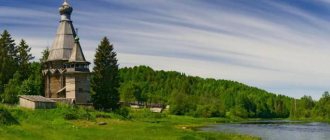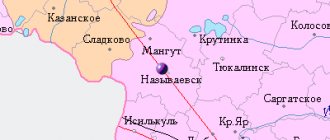The city of Ostrovnoy is a small town in the Murmansk region
A city with the status of a closed administrative territorial entity (ZATO). They will be located on the shores of the Svyatonossky Bay of the Barents Sea in the northeastern part of the Kola Peninsula. The territory of the entire urban district consists of two large microdistricts, which are located at a distance of 3.5 km from each other and are connected by bus and sea. The city of Ostrovnoy itself was built in Soviet times. Murmansk-140 is also used as its name. The polar city is more than 400 years old. You can get to civilization only by water, as well as by air. Local residents of the tundra engage in hunting, fishing, and picking mushrooms and berries. These are important components for a happy life for residents. Despite numerous problems, many of them feel happy, explaining that, first of all, mental comfort is required for a person’s happiness. Many have left, but many remain. Perhaps it is this spiritual comfort that residents are afraid of losing when moving to big cities.
Admiral's Farewell
I remember parting with Ostrovny. "Vaclav Borovsky" has about an hour's stop here on the Arkhangelsk-Murmansk flight. As soon as the ship moored, we loaded onto it, threw our things into the cabin, went out onto the upper deck and, standing at the side, looked at the abandoned town. At this time, three passenger cars drove out to the pier, followed by a UAZ. The admiral came out of the lead car, followed by several officers of various ranks, then about five sailors, who immediately began, under the supervision of the lieutenant, to carry the admiral’s luggage along the ladder aboard the ship. The admiral himself and his retinue went into the captain's salon of the ship. The time for departure approached, but the gangway was not removed and no whistles were given. About 20-30 minutes after the appointed departure time, red-faced officers from the admiral's escort began to appear on the ramp. It can be seen that the dumping was carried out at a high level. When the last of them stepped onto the pier, the gangway was immediately removed and a long whistle sounded. The officers remained standing on the pier along the side. The admiral went out onto the upper deck, waved to them, they took their visor, and the ship immediately set off. While we were moving inside the harbor, one could still see a group of officers remaining on the pier. As soon as we entered the open sea, it blew strongly, and people from the upper deck hurried inside the ship. I lingered for a while at the top, where the admiral still remained. For a long time he looked beyond the stern of the ship towards the now barely visible Ostrovny. Having completely frozen in the wind, I went to our cabin, where we had our own modest dump. In the morning we left “Vaclav Borovsky” in Murmansk.
Magazine: Historical Truth No. 1, January 2021 Category: Windswept Author: Konstantin Riches
Tags: USSR, Historical truth, ghost town, city, submarine, fleet, Navy, Murmansk, Ostrovnoy, Gremikha
- Back
- Forward
Ithory
The first mention of the village dates back to 1611.
In 1915, work began on the construction of the first naval base. In 2008, the base was used to store decommissioned submarines. The city currently stores spent nuclear fuel from Northern Fleet submarines. The city is the only place where it is possible to recharge reactors with rare metal coolant. It was planned that Gremikha would be cleared of nuclear fuel by 2021. The climate is dominated by strong winds and large clouds. Ostrovnoy is one of the smallest cities in Russia. There are a lot of fish and sea animals here. At Cape Svyatoy Nose the warm Gulf Stream ends. In this place, the waters of two seas meet, which wash the Kola Peninsula - White and Barents. The climate in this place is moderately cold. Cold winters last a long time, and summers are cold and cool.
Despite the fact that the city's population is gradually declining, this wonderful place is of great interest to tourists.
Gremikha and Shoina are two neighboring villages
The village of Gremikha is located on the eastern shore of the Kola Peninsula, Murmansk region. The village of Shoina lies on the western coast of the Kanin Peninsula, Arkhangelsk region. Two neighboring peninsulas. They are separated only by two hundred kilometers of sea water.
These settlements have a lot in common, but there are also many differences. If Gremikha is located on a rocky surface, at an altitude of up to three hundred meters above sea level, then Shoina is on a low-lying, sandy surface and is separated from the invasion of sea waves only by sand dunes.
Both of these places have always been dangerous for navigation. In the Gremikha area there is a junction of the two seas, the White and Barents seas, the coast is rocky. Gremikha is the capital of the winds. The Shoina sea area is dangerous due to its sandy shoals and also frequent, strong northwest winds.
I had to sail, as a passenger of course, from Shoina to Arkhangelsk and back on the motor ship “Mudyug”, and later on the motor ship “Yushar”. From Murmansk to Gremikha and back on the motor ship “Sestroretsk” and on the motor ship “Ilya Repin”, from Arkhangelsk to Gremikha on the motor ship “Vaclav Vorovsky”. And the White Sea was not always calm. There were cases when ships waited out stormy weather near the island of Morzhovets. Even such a huge ship as the Vaclav Vorovsky was tossed on the waves like a matchbox in stormy weather when approaching Gremikha.
It just so happened that these two villages played a big role in my life and I consider it my life’s duty to tell about them in one book.
In one of these villages (Shoine) I grew up and received an education, and in another (Gremikha), I spent the three most significant years of my youth for me, when I served in the ranks of the Soviet Army.
The city's attractions
The city has its own attractions. Among them are many monuments and other attractions:
- Monument to the Deer.
- Monument to the victims of the Yokanga prison.
- Monument to the victims of the intervention.
- Monument to submariners who died during the Great Patriotic War.
- Memorial plaque in honor of the crew members of the nuclear submarine "K-159".
- Svyatonossky Bay.
Buses run within the city, and there is also a water connection with the city of Murmansk.
Go to the Murmansk region attractions page
Yokanga, Gremikha, Murmansk 140, Ostrovnoy
Prehistory of the village of Gremikha
The first mention of the settlement Yokanga (the name of the village of Gremikha until 1938) exists since the 16th century, as a Sami graveyard (a graveyard is an analogue of a modern rural settlement, village). The Sami are a small Finno-Ugric people, an indigenous people of Northern Europe. The Russians called them Lapps. The traditional crafts of the Sami in those days were domestic reindeer herding, hunting and fishing.
The village is located in the Murmansk region, on the eastern coast of the Kola Peninsula, 360 kilometers southeast of Murmansk at the junction of the Barents and White Seas. Moreover, the border of the seas is visible. The color of the water and its transparency on the parallel of Cape Svyatoy Nos changes literally before our eyes.
“This happens from the meeting of two currents - the powerful tidal White Sea and Murmansk branches of the famous Gulf Stream. From the collision of water masses, a curious and unpleasant thing happens for sailors - Svyatonossky suloi (seething waves and whirlpools). In ancient times, the Arkhangelsk Pomors, who went to the Murmansk coast for cod, went around the sula, dragging their carbass across the cape directly into the Svyatonossky Bay.”
In 1822, Fyodor Litke, who was conducting hydrographic research off the coast of the Kola Peninsula, drew attention to the exceptional convenience of a section of the coast covered by islands near Cape Svyatoy Nos for basing ships. Moreover, this section from Murmansk to Yokanga does not freeze in winter due to the warm Gulf Stream, i.e. Navigation in this area is year-round.
In 1915, the tsarist government allocated money for the construction of a naval base in these places. From Murmansk and Arkhangelsk, ships with various cargoes and people are sent to Cape Svyatoy Nos. But by 1917 work was stopped. The unfinished base was turned into the Yokanga convict prison. It was not as widely known as Mudyug Island near Arkhangelsk, but it was here, to the Yokanga prison, that those who survived the uprising on Mudyug Island in September 1919 were brought. In its five months of existence, more than 1,200 prisoners passed through Yokanga; 300 of them died, several dozen were shot. As a result of the uprising, on February 21, 1920, the Yokanga convict prison ceased to exist.
Gremikha during the Great Patriotic War
Before the Great Patriotic War, the second stage began to create a naval base in Yokanga, already renamed Gremikha.
In 1940, the Soviet government decided to create a Northern Fleet base in these places to protect communications on the approach to the White Sea. The first builders were sent here. In the same year, the first ships of the Northern Border Detachment appeared here.
On June 22, 1941, the day the Great Patriotic War began, the commander of the Northern Fleet, Rear Admiral A.G. Golovko, signed an order to create the Yokanga Naval Base. The base then included patrol vessels of the fishing fleet and boats. The submarines of the 3rd division of the submarine brigade based in the city of Polyarny were transferred to the commander of the Yokanga naval base. The 14th local rifle company was formed.
The mission of the ships was to protect the throat of the White Sea from Cape Svyatoy Nos to Cape Kanin Nos from the penetration of enemy ships and submarines, perform patrol duty and escort transport in their zone. Enemy submarines never entered the White Sea during the entire war, but constantly appeared in the northern part of the throat. Since the end of 1941, ships of the Yokang Naval Base in their zone began to meet and accompany ships of northern convoys. During the war years, the ships of the Yokanga naval base escorted 700 transports and delivered more than 2 million tons of cargo.
The ships dropped anchor in the roadstead because there were no piers, no moorings, no housing, no electricity. Combat missions came first.
In the summer of 1942, the first part of military construction workers arrived in Gremikha. A construction battalion numbering about 1,000 people built military facilities, fortified firing points, and a field airfield.
At the same time, a water supply system was built in Gremikha and repair shops were organized. In 1943, the base acquired its own dry dock. During the war years, several coastal batteries were built here, reliably covering the base from the sea.
The local population of Gremikha made a significant contribution to the fight against the German aggressors. In the very first days of the war, a militia company was created. The Sami became fighters in reindeer transport units. Soldiers on reindeer sleds delivered ammunition, fuel, and food to the front line, and evacuated the wounded.
Gremikha in the post-war period
In July 1956, the 14th Separate Submarine Brigade was formed. It included seven diesel submarines and a floating base. Before this, only water area security forces and fleet rear depots were stationed in Gremikha.
In the same year, the first residential building was built three kilometers west of Gremikha, near Ostrovskaya Bay. This year is considered the year the village of Ostrovnoy was founded. At the same time, an underwater cable for military telephone and telegraph communications with Severomorsk and Novaya Zemlya was put into operation.
On August 4, 1957, the Decree of the Presidium of the Supreme Soviet of the RSFSR “On classifying the settlement of Gremikha, the center of the Sami district of the Murmansk region, as a working settlement” was issued.
In 1958-1959 to ensure conditions for basing ships between the mainland of the Svyatonossky Gulf and Witte Island, a mole was built (a hydraulic protective structure to protect the port water area from waves, adjacent at one end to the shore). Subsequently, floating berths were added to it. In 1960, 17 submarines were already based at the Yokanga roadstead.
On July 1, 1960, a US Air Force RB-47 was shot down near Cape Svyatoy Nose. Of the 6 crew members, two were rescued by Arkhangelsk fishing trawlers. In January 1961, they were transferred to the American side.
On September 1, 1963, a new ship PM-130 arrived at the Yokang Naval Base, which marked the beginning of the formation of a floating repair plant in Ostrovnaya.
Gremikha - an outpost of the Soviet nuclear fleet in the North
At the turn of the 60s, the era of the nuclear fleet began. The government of the USSR, the command of the Northern Fleet, understanding the extremely advantageous strategic position of the base, makes it an outpost of the Soviet nuclear fleet in the North.
The first-born of Soviet nuclear-powered ships in Gremikha was the K-3 submarine. After all tests were completed at the end of 1959, the K-3 submarine arrived at the Yokanga naval base. Seven more boats followed, after which the first submarine association in our country was created.
From July 11 to July 17, 1962, fulfilling a special task of the government, the K-3 submarine, for the first time in the history of Soviet navigation, made an Arctic crossing crossing the North Pole point and received the name “Leninsky Komsomol”, in memory of the boat of the same name, which did not return from a combat mission in July 1943 of the year.
In July 1962, the base was visited by a government delegation led by Nikita Sergeevich Khrushchev.
In February-March 1966, the base's nuclear boats made the world's first group voyage around the world, covering 25 thousand miles.
On June 1, 1966, on the basis of the 14th Separate Brigade and the 209th Submarine Brigade, the 17th Submarine Division of the Red Banner Northern Fleet was formed.
In 1967, 2nd generation nuclear boats began arriving at the Yokanga naval base. In the same year, the base was visited by a Government Commission headed by the General Secretary of the CPSU Central Committee Lenid Ilyich Brezhnev. As a result of this visit, allocations for construction are significantly increased, and the village of Ostrovnoy begins to rapidly expand. By the end of the 60s, builders were commissioning the House of Officers, a school, a hospital, and the Orbita station.
The Yokanga naval base became the largest in the Northern Fleet, where strategic missile submarines have been based since 1968.
The author of this book served in 1965-68 in an air defense regiment located five kilometers from Gremikha. The missile regiment was on constant combat duty to protect the Yokanga Naval Base.
All the years after my service, I was proud that fate brought me to Gremikha. Later in the book there will be my stories about serving here. This pride was aroused by memories of what he saw during his years of service. There was confidence that our Motherland was reliably protected in the North.
Post-perestroika Gremikha
After serving in the army, I never had to visit these places again. I’ve been to Murmansk and Severomorsk, but I never had to go to Gremikha.
In 1981, Gremikha was renamed again and called the closed city of Ostrovnoy, and in 1982 Ostrovnoy became Murmansk-140. In 1994, Murmansk-140 was renamed ZATO Ostrovnoy.
The Internet has made it possible, albeit virtually, to visit there. Imagine my surprise and indignation at what I saw there. I cannot speak about this in my own words. I will quote the words of the sailor who published his story “Gremikha. History and reality” on the Proza.ru website.
“Until the end of the 80s, nuclear-powered ships of the Yokanga naval base actively plied the icy waters of the North Atlantic and the warm Mediterranean Sea. But the political and economic processes that took place in the country and affected all spheres of life in the most regrettable way affected the country’s defense capability and had a serious impact on the condition of the Northern Fleet in general, and the Yokanga naval base in particular.
Since the beginning of the 90s, nuclear-powered ships, due to lack of funds, have been entering combat service less and less often. Since 1992, Gremikha began to decline as a naval base, even despite the creation of the Closed Administrative Territorial Entity (ZATO) Ostrovnoy. The most combat-ready crews and boats go to other bases. A huge number of experienced officers and midshipmen are being cut. From December 1, 1995, the Yokanga Naval Base became the Yokanga basing area. There is devastation everywhere, just like after the war.
In 2008, I visited Yokanga and Ostrovnoy for the last time, going on a voyage on the ship “Klavdiya Elanskaya”. What was the glory of the Northern Fleet in the 70-80s looked like Stalingrad in 1942. I was struck by the devastation and desolation. Houses with empty sockets of windows and doors, dirt, thickets of grass, mountains of garbage and remnants of rusting metal. My soul became sad from the mismanagement of management and my own powerlessness to do anything. What was it like for the military and sailors to see all this?!”
THEN the city of Ostrovnoy (Gremikha) today
From the general description: “The closed administrative-territorial formation of the Ostrovnaya Murmansk Region is located on the coast of the Barents Sea near the Yokanga Islands and the Svyatoy Nos Peninsula, at a distance of 360 km. from the city of Murmansk and 430 km. from the city of Arkhangelsk. Communication with the ZATO of Ostrovnoy is carried out only by sea; there are no roads or railways. The means of delivering population, food and other vital goods is the motor ship “Klavdiya Elanskaya” (JSC “Murmansk Shipping Company”).
The city consists of two microdistricts located five kilometers from each other, and connected by regular intracity bus service.
Currently, the economic basis of the ZATO of Ostrovnoy consists of: budgetary organizations, government institutions, municipal unitary enterprises, individual entrepreneurs, facilities of the Ministry of Defense of the Russian Federation and the Gremikha department of the North-Western Center (NWC) for radioactive waste management “SevRAO” of the State Corporation “Rosatom”.
The population of the Ostrovnoy municipality is just over 2,200 people. During the Soviet period, the population reached 30 thousand people.
Websites: Official website of the Ostrovnoy city administration
Shoina on the Kanin Peninsula
Prehistory of the village Shoina
Historical documents show that the places where the village of Shoina is located today, and this is the western coast of the Kanin Peninsula, washed by the White Sea, were inhabited by Samoyed tribes (the ancestors of the present-day Nenets) in the middle of the last century. The Nenets, and later the Komi-Izhemtsy who joined them, have long been engaged in reindeer herding on the Kanin Peninsula and led a nomadic lifestyle. This tradition has been preserved to this day. In the summer, reindeer herders graze herds of reindeer in the northern part of the peninsula, and in the winter they migrate to the Mezen and Pinega forests. The place where the village of Shoina is located was sacred to the aborigines; they always stopped here during their nomadic periods.
In the book of famous local historians Nikolai Okladnikov and Vladimir Matafanov, “The Path of Christianity in the North,” it is said: “Shoina dates back to 1825. At the end of July 1825, a certain Khekhulya Barakulev, expelled by his fellow tribesmen from Kanin for his obvious predisposition to the new Christian faith, built a house at the mouth of the Shoyna River, thereby laying the foundation of the future village.”
In the 14th-16th centuries, the Pomors increasingly began to go out on their boats and boats to the throat of the White Sea, including the Shoina River. Pomors are the descendants of ancient Russian settlers, mainly from the Novgorod land. They inhabited the territory of the southwestern and southeastern coasts of the White Sea in the 12th – 18th centuries. They came here for furs, poultry, salt, sea fish and animals. They built temporary shelters and even houses.
Some Mezen men, who regularly hunt fish and sea animals in these areas every year, began to gradually move here with their families, building or transporting their houses here. Despite the harshness of the region, people were attracted by the freedom, wealth and beauty of these places.
